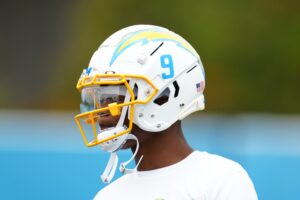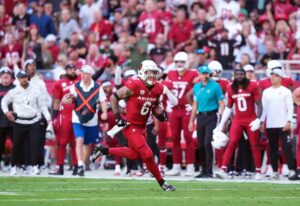To describe this year’s Seattle Seahawks offense as “bipolar” would be an understatement. One game, quarterback Russell Wilson and his arsenal of offensive playmakers are driving downfield and scoring effortlessly. The next, they look anemic, struggling even to move the ball into field goal range. Even more inexplicably, they seem to play their strongest against quality teams, while appearing the most tepid against weaker competition.
So, how to account for this discrepancy in offensive performance? A closer look at games where the offense has stalled out may prove revealing.
Making Sense of the Seattle Seahawks Inconsistent Offense
One reason for Seattle’s offensive woes this year is a schedule that includes underrated defenses. This is especially true of the Los Angeles Rams, who defeated the Seahawks 9-3 in week two at their home opener. This game contained historic implications for the Rams, since they were playing in Los Angeles for the first time since the glory days of Eric Dickerson. The momentum of home-field advantage favored the Rams in this game, and the Hawks missed the encouragement of their exuberant fans, affectionately known as the “12th Man.”
Although the Rams have experienced their share of troubles this year, they’ve had their moments. They possess an excellent defensive line that includes two-time Pro Bowler Robert Quinn and star tackle Aaron Donald. This matchup paired up well against a Seahawks offensive line whose troubles this year are well documented.
This game also took place early in the season while the Seahawks were still struggling to find their rhythm. The play calling was one dimensional, mostly draw plays to running backs Christine Michael and C.J. Prosise. This approach was doomed from the beginning, since the ailing offensive line could not provide any line surge or open up any substantive running lanes. The Seahawks needed more time for preparation in order to expand their playbook.
In the games that followed, the Seahawks offense began to excel. Perhaps most notably, they were able to integrate tight end Jimmy Graham into their plans. For the first time since his acquisition from the New Orleans Saints, Graham played in dominant fashion. Graham’s trademark screen passes do not require much time to develop, helping to remedy the team’s problems in providing pass protection.
Recently, the return of power running back Thomas Rawls has provided a much needed spark. Rawls’ substantial gains on first down set up a variety of options for Doug Baldwin, Tyler Lockett and the talented receiving corps. Coach Pete Carroll and offensive coordinator Darrell Bevell can opt to take a shot downfield, or simply gain the first down yardage they need with short passes that are exceedingly difficult to prevent.
The Seahawks’ offense actually played well in their loss to the New Orleans Saints. Towards halftime, the offense was marching downfield with a comfortable cushion when a rare Wilson interception turned the tide in favor of their opponent. This miscue was more the result of an excellent diving grab by linebacker Nathan Stupar than an errant pass by Wilson. Even though they fell short, the Seahawks had a chance to win at the end. The result may have been more favorable if the Hawks were playing at CenturyLink Field, their cherished home stadium.
It would be remiss not to mention the tumultuous game against their divisional rivals, the Arizona Cardinals. Was it mediocre offense or masterful defense that resulted in this rare tie, the first such outcome in franchise history? A good deal of both, actually. Once again, the offensive line’s inability to block a talented defensive line left the Seahawks in paralysis. Arizona dominated the field possession and time of possession battles, forcing the Seattle offense to play with its back against the ropes most of the game. If not for stellar play by the Legion of Boom, the outcome may not have been even close.
Finally, the Seahawks struggled again when they played against the Tampa Bay Buccaneers. The defense allowed two early touchdowns, forcing Seattle’s offense to play from behind all game. This early deficit caused the offense to stray from its winning formula, first down yardage that keeps opponents guessing on second and third downs. Key injuries, including the absence of center Justin Britt, also disrupted their game plan. Once again, fatigue and the absence of momentum from playing on the road also had an effect.
The Seahawks followed up this frustrating performance with a 40-point explosion against the Carolina Panthers. Performances like this one, as well as their impressive play against the New England Patriots, demonstrate the Seahawks have the potential to be an offensive juggernaut. Inconsistent play all season long has left fans scratching their heads and wondering “Will the real Seahawks offense please stand up?” The answer will determine whether Russell Wilson will once again be lifting the Lombardi Trophy at season’s end.






